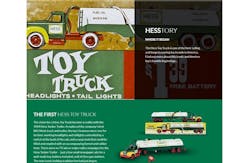Hess Toy Gas Trucks to Stick Around: So That Happened
Editor’s note: Welcome to So That Happened, our editors’ takes on things going on in the manufacturing world that deserve some extra attention. This will appear regularly in the Member’s Only section of the site.
Heritage Cannabis, Like Gets All Efficient and Stuff
If there’s anything that the legal marijuana industry is known for, it’s running a tight ship. No other industry achieves equal levels of operational excellence and employee engagement.
Case in point? Vancouver, British Columbia, Canada-based Heritage Cannabis. By adopting new software from Elevated Signals (I guess High Sign would have been too on the nose?), the industrial joint rollers slashed admin work by 50%, raised right-first-time metrics from about half of its product to more than 80% and cut filling time by 90%, all before 4:20 p.m.
The key, of course, was slashing paper in favor of water pipes… oh wait, digital processes.
Paraphrasing a quality assurance employee, before using the software, you had to wander department to department asking who’d done anything. You’d be like, hey, did you guys fill line two, and everyone would be like, “Dave’s not here, man.”
Or, in her own words:
“Before Elevated Signals, our QA team was buried in paperwork, chasing missing info, walking records between departments and spending hours filing,” said Katrina Andersen, quality assurance associate at Heritage Cannabis. “Now, everything is captured correctly the first time, and batch reviews happen instantly, whether I’m onsite or not.”
Like many companies, Heritage leaders were looking to streamline paperwork, but with the software in place, they’re getting better real-time views of operations, informing better KPIs and improved workflows.
Paraphrasing Elevated Signals CEO Amar Singh, it’s not just about checking boxes for regulators. It’s all about getting into a flow and bringing more love to the world.
Or, in his words:
“Regulated manufacturers deserve tools that don’t just check compliance boxes, but actually make their businesses better,” Singh said.
—Robert Schoenberger
Fine Art Is So METAL!
In the hopes of inspiring young people and developing the future steel and metal manufacturing workforce, Patterns of Meaning, an art initiative consisting of paintings, sculptures and artifacts honoring the industrial era, has partnered with the Metallurgical Engineering Trades Apprenticeship & Learning (METAL) program to pilot its K-12 fine art curriculum in public schools in Pennsylvania’s Allegheny County.
“The goal of Patterns of Meaning is to update the cultural perception of heavy manufacturing from a dying industry to a creative and vital essential human contribution,” said Cory Bonnet, Pittsburgh-based artist and Patterns of Meaning founder. "Manufacturing – including steel and metal production – is necessary for the future and depends on new artisans capable of the creativity and innovation it requires.”
The curriculum will include field trips to the Patterns of Meaning Exhibit Hall in Pittsburgh and art projects that focus on the metalworking industry. The project-based learning curriculum will include drawing, painting and collage for younger students, while more complex projects for advanced learners will include computer-aided design, wax models, sand casting and additive manufacturing processes.
"We applaud Patterns of Meaning for its innovative efforts to transform public perceptions of the steel industry and manufacturing through fine arts,” said METAL National Workforce Manager Lucinda Curry.
—Anna Smith
Department of Labor Soliciting Public Input on Retirement Plans
On Monday, the Department of Labor, via the Employee Benefits Security Administration, announced it is seeking public opinions on helping small employers offer “pooled employer plans.”
Pooled employer plans, or PEPs, are an alternative retirement savings plan to a traditional pension or a 401(k). Like a 401(k), they are a defined contribution plan, where the employer pays into a retirement account. Unlike a 401(k), fiduciary responsibility and administrative tasks are offloaded to a third party “pooled plan provider,” or PPP. The Department of Labor says this can reduce administrative costs and fiduciary responsibilities for employers.
In a statement accompanying the Request for Input (RFI), Department of Labor Deputy Secretary Keith Sonderling said the Department is committed to helping Americans save for retirement, and is seeking information to promote PEPs and identify how employers are already using them.
“This request for information is a key step toward identifying ways to help smaller employers lower costs and improve retirement outcomes for their employees,” Sonderling said.
The Department of Labor Employee Benefits Security Administration’s request for information on pooled employer plans will include a 60-day period for public comment.
— Ryan Secard
Flowserve’s Out, Baker Hughes is in at Chart Industries
Less than two months after announcing a merger of equals with Flowserve Corp. (No. 246 on the IndustryWeek U.S. 500 list of the largest publicly traded manufacturing companies), engineered gas- and liquid-tank producer Chart Industries (No. 265) has called off that deal so it can be purchased by oil and gas equipment giant Baker Hughes (No. 54) for $13.6 billion.
Baker Hughes Chairman and CEO Lorenzo Simonelli said, “[Chart’s] products and services are highly complementary to our offerings and strongly aligned with our intent to deliver distinctive and efficient end-to-end lifecycle solutions for our customers across their most critical applications. The combination positions Baker Hughes to be a technology leader that can provide engineering and technology expertise to meet the growing demand for lower-carbon, efficient energy and industrial solutions across attractive growth markets such as LNG, data centers and new energy.”
Chart’s liquefied natural gas compression and storage systems have gained more notice in recent years as an abundance of shale gas in the United States makes it possible to export fuels to Europe and other areas.
Chart President and CEO Jill Evanko said the deal will provide immediate value to Chart’s shareholders in the form of $210-per-share cash payouts. Before the Baker Hughes’ announcement Tuesday, shares had been trading for about $170 per share.
And, the immediate value stands in contrast to the proposed merger of equals with Flowserve, a deal announced at the beginning of June. Unlike the cash payment from a buyer, Evanko said that merger was about building a combined company that would grow into higher earnings, eventually.
“Together we will provide a complete system of capabilities from front-end engineering design to mission critical equipment through aftermarket and servicing, delivering high-quality, value-added solutions to an expanded, global customer base,” Evanko said in June.
Breaking off the deal will force Chart to pay Flowserve a $266 million breakup fee.
Flowserve President and CEO Scott Rowe said, “The decision not to pursue a revised offer for Chart demonstrates our commitment to financial discipline, as well as our confidence in the growth prospects of our standalone business. Our results reflect the successful execution of our 3D growth strategy—Diversify, Decarbonize, and Digitize—while the Flowserve Business System continues to enhance productivity, expand margins, accelerate decision-making, and unlock long-term value.”
—Robert Schoenberger
How to Solve Retention and Reshoring
Hexagon a few weeks ago released its “2025 America’s State of Manufacturing Report.” Two tidbits caught my attention.
According to the report, 72% of respondents claim outdated technology prevented them from attracting and retaining workers. The report paints the picture of new employees turning their noses up at paper binders.
I really don’t think that’s the problem attracting and retaining workers. At least in my experience, most operators on the shop floor only deal with MES or CMMS for things like reading their work instructions for the day or making notations on tablets, simple tasks that enhance performance.
But the bulk of the work still revolves around CNC mills, dies and molds, presses and torque guns. Never in any of these reports that essentially proselytize digital transformation do I see anything about operators complaining about the antiquity of machines on the shop floor.
Which brings me to the second tidbit of interest. According to the report, 31% of respondents expect to invest more in reshoring if tariffs rise. And, 50% of respondents say it would take one to three years or more to staff those operations.
That’s how things stood before the U.S. government decided to enact strict immigration policies and strip businesses of vital workforce. The New York Times recently covered a meat-packing plant that lost almost half its workers after a raid and now struggles to keep producing.
Manufacturers face a double-whammy. “Move production to the U.S. but also while your workforce problems exacerbate because Americans don’t want to take the jobs that need replacing.”
I’m no workforce expert but I don’t think paper binders are the reason manufacturing can’t attract workers or why Americans don’t want to do take manufacturing jobs. It feels like wages are the issue here, but what do I know?
—Dennis Scimeca
The Hess Toy Truck Will Drive On
Energy titan Chevron Corp. recently won the battle for Hess Corp. after a favorable ruling on contract language by an arbitrator appointed by the International Chamber of Commerce. Now comes the nitty-gritty work of integrating the businesses’ operations around the world—as well as preparing to hand over a toy truck venture to Hess’ former CEO.
Chevron directors on Monday voted to have John Hess join their ranks. That’s standard operating procedure with a lot of acquisitions. What isn’t is that, two weeks earlier, Hess and company officials signed a memorandum of understanding about the future of Hess Toy Truck LLC, which owns the assets of the storied toy brand that dates back more than 60 years.
Per the parties’ agreement, Chevron will run Hess Toy Truck until next April and store and ship the original B61 Mack Hess oil delivery truck as well as other artifacts. Come next spring, an independent appraiser will put a value on the business that Hess will pay. Between now and then, Chevron will sell to Hess trademarks, logos, websites and other intellectual property using the Hess name in return for an exclusive and perpetual license to use the Hess brand in its oil-and-gas operations.
Also included in the July 14 MOU? Various transition services for Hess—think office space and tech support—as well as a much larger toy: Come Oct. 1, Chevron will sell to Hess its stake in a company that leases a plane, hangar and tools. Hess will then pay roughly $25 million to buy the aircraft outright.
—Geert De Lombaerde
About the Author
Robert Schoenberger
Editor-in-Chief
LinkedIn: linkedin.com/in/robert-schoenberger-4326b810
Bio: Robert Schoenberger has been writing about manufacturing technology in one form or another since the late 1990s. He began his career in newspapers in South Texas and has worked for The Clarion-Ledger in Jackson, Mississippi; The Courier-Journal in Louisville, Kentucky; and The Plain Dealer in Cleveland where he spent more than six years as the automotive reporter. In 2014, he launched Today's Motor Vehicles (now EV Manufacturing & Design), a magazine focusing on design and manufacturing topics within the automotive and commercial truck worlds. He joined IndustryWeek in late 2021.
Anna Smith
News Editor
News Editor
LinkedIn: https://www.linkedin.com/in/anna-m-smith/
Bio: Anna Smith joined IndustryWeek in 2021. She handles IW’s daily newsletters and breaking news of interest to the manufacturing industry. Anna was previously an editorial assistant at New Equipment Digest, Material Handling & Logistics and other publications.
Ryan Secard
Associate Editor
Ryan Secard joined Endeavor B2B in 2020 as a news editor for IndustryWeek. He currently contributes to IW, American Machinist, Foundry Management & Technology, and Plant Services on breaking manufacturing news, new products, plant openings and closures, and labor issues in manufacturing.
Dennis Scimeca
Dennis Scimeca is a veteran technology journalist with particular experience in vision system technology, machine learning/artificial intelligence, and augmented/mixed/virtual reality (XR), with bylines in consumer, developer, and B2B outlets.
At IndustryWeek, he covers the competitive advantages gained by manufacturers that deploy proven technologies. If you would like to share your story with IndustryWeek, please contact Dennis at [email protected].
Geert De Lombaerde
Senior Editor
A native of Belgium, Geert De Lombaerde has been in business journalism since the mid-1990s and writes about public companies, markets and economic trends for Endeavor Business Media publications, focusing on IndustryWeek, FleetOwner, Oil & Gas Journal, T&D World and Healthcare Innovation. He also curates the twice-monthly Market Moves Strategy newsletter that showcases Endeavor stories on strategy, leadership and investment and contributes to other Market Moves newsletters.
With a degree in journalism from the University of Missouri, he began his reporting career at the Business Courier in Cincinnati in 1997, initially covering retail and the courts before shifting to banking, insurance and investing. He later was managing editor and editor of the Nashville Business Journal before being named editor of the Nashville Post in early 2008. He led a team that helped grow the Post's online traffic more than fivefold before joining Endeavor in September 2021.



